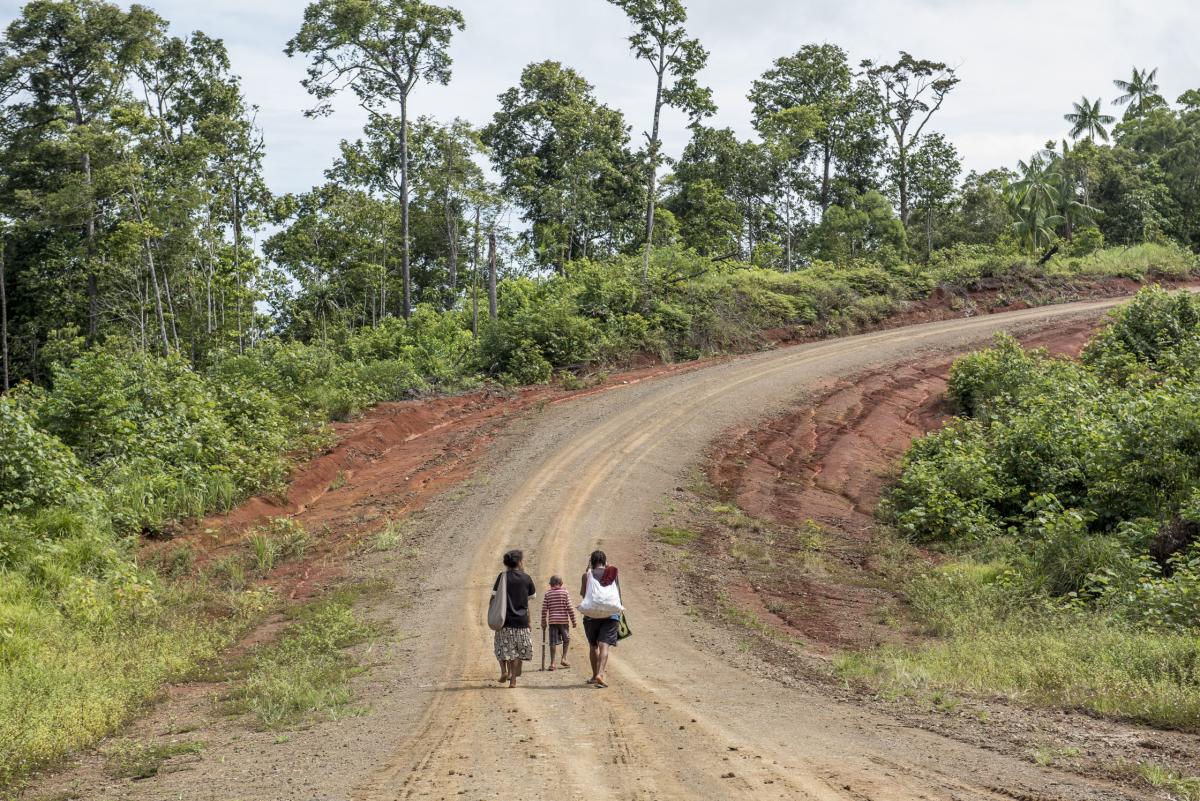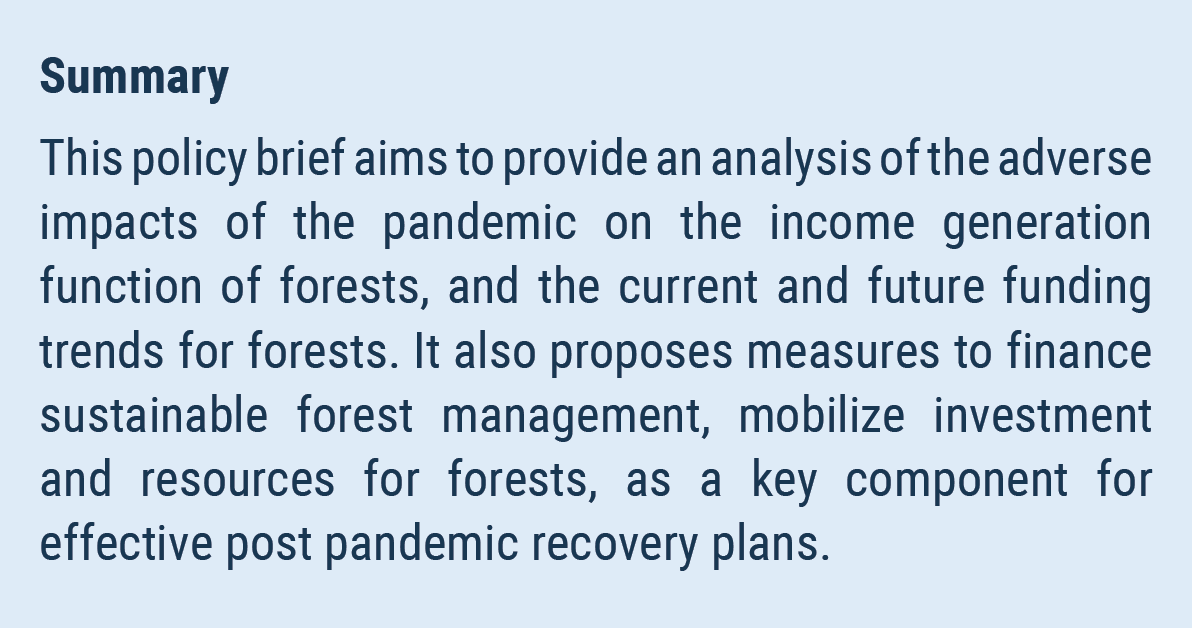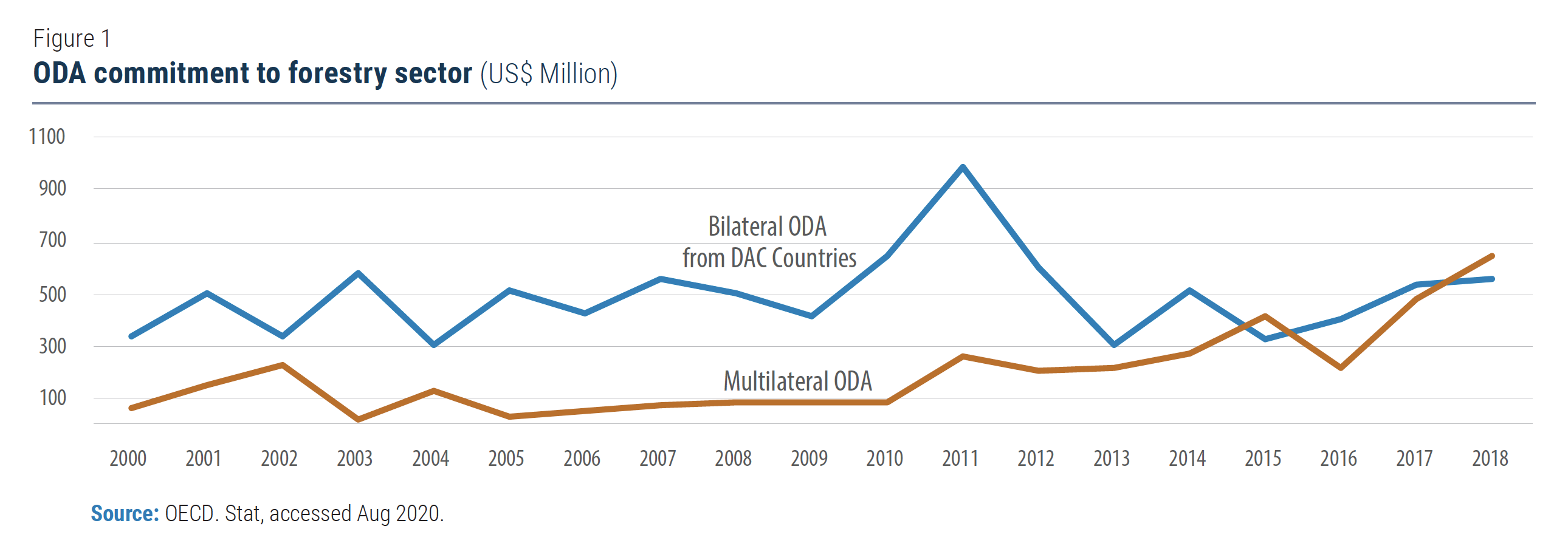
 Zoonotic diseases account for about 60 per cent of known infectious diseases in humans and 75 per cent of all emerging infectious diseases (UNEP, 2020). This rising trend is caused by, among others, increased degradation of the natural ecosystems such as forests. Loss of forest habitat increases contact between humans and nonhuman primates and the transmission of diseases from animals to humans. The COVID-19 pandemic is thus a compelling cautionary tale of what can happen when natural ecosystems are degraded. While the full scope and depth of the impact of the ongoing pandemic is still unfolding, initial analysis indicates that there will be a long recovery ahead. It is estimated that the pandemic could push 100 million more people into extreme poverty and reduce the global GDP by 5.2 per cent in 2020, which could lead to the deepest global recession since the Second World War (WB, 2020). During the current pandemic, the forestry industry is playing a key role in providing raw materials for critical daily essentials, ranging from hygiene products, masks and other medical supplies to packaging materials for essential goods. Forests have also been providing a safe space for socially distanced recreation while alleviating increased stress and anxiety caused by COVID-19, especially in urban areas. Forests provide a wide spectrum of benefits and services, from ecological stability to income and livelihoods for millions of people. They serve as a safety net to the rising number of the extremely poor (DESA, 2020). They offer nature-friendly solutions to recover from social and economic impacts of the pandemic, and to build sustainable, resilient and fair societies capable of withstanding future pandemics and other global challenges, such as climate change and biodiversity loss. Yet, forests continue to be threatened in many regions by unsustainable activities and natural disasters. The COVID-19 pandemic has increased pressure on forest resources. In view of the emergency humanitarian needs caused by the pandemic, financial resources for forests are currently at risk of being reduced. Sustainable forest management, including adequate financing, is therefore a key component of effective and resilient recovery from COVID-19. Investing in forests—through maintaining pre-crisis commitments and unlocking new opportunities—is investing in a sustainable future for people and the planet.
Zoonotic diseases account for about 60 per cent of known infectious diseases in humans and 75 per cent of all emerging infectious diseases (UNEP, 2020). This rising trend is caused by, among others, increased degradation of the natural ecosystems such as forests. Loss of forest habitat increases contact between humans and nonhuman primates and the transmission of diseases from animals to humans. The COVID-19 pandemic is thus a compelling cautionary tale of what can happen when natural ecosystems are degraded. While the full scope and depth of the impact of the ongoing pandemic is still unfolding, initial analysis indicates that there will be a long recovery ahead. It is estimated that the pandemic could push 100 million more people into extreme poverty and reduce the global GDP by 5.2 per cent in 2020, which could lead to the deepest global recession since the Second World War (WB, 2020). During the current pandemic, the forestry industry is playing a key role in providing raw materials for critical daily essentials, ranging from hygiene products, masks and other medical supplies to packaging materials for essential goods. Forests have also been providing a safe space for socially distanced recreation while alleviating increased stress and anxiety caused by COVID-19, especially in urban areas. Forests provide a wide spectrum of benefits and services, from ecological stability to income and livelihoods for millions of people. They serve as a safety net to the rising number of the extremely poor (DESA, 2020). They offer nature-friendly solutions to recover from social and economic impacts of the pandemic, and to build sustainable, resilient and fair societies capable of withstanding future pandemics and other global challenges, such as climate change and biodiversity loss. Yet, forests continue to be threatened in many regions by unsustainable activities and natural disasters. The COVID-19 pandemic has increased pressure on forest resources. In view of the emergency humanitarian needs caused by the pandemic, financial resources for forests are currently at risk of being reduced. Sustainable forest management, including adequate financing, is therefore a key component of effective and resilient recovery from COVID-19. Investing in forests—through maintaining pre-crisis commitments and unlocking new opportunities—is investing in a sustainable future for people and the planet.
Impact of covid-19 on income and services from forests
The restrictions on transportation and closure of borders due to COVID-19 have affected lives of forest-dependent people and the management of forest resources. Both wood and non-wood forest industries have been impacted by the pandemic, causing reduced revenue for private, public and community-based enterprises and leading to increased unemployment and loss of income from formal and informal forest sectors. While there has been an increased demand for some forest-based products, including packaging materials, toilet paper and masks, the wood industry has been impaired by the disruptions in global supply chains and overall decreased demand for wood products. The situation is exacerbated by the impeded performance of sectors relying on wood products as raw materials, such as construction and automotive manufacture (ILO, 2020). Public and private forest enterprises are now strained by income loss and a cash flow crisis. Micro, Small and Medium Enterprises (MSMEs), small forest owners and indigenous peoples, which have limited access to the formal capital market, suffer the most. Job losses in forest sectors have been reported to be on the rise—from full-time employment to informal, seasonal and migrant workers. COVID-19 has caused job and income loss from informal sector in the non-wood forest industries. For example, in Madagascar which is renowned for its forest-based tourism, the pandemic is expected to cause an estimated loss of 80 per cent of tourism business affecting 44,000 direct jobs and more than 300,000 indirect jobs (La Verite, 2020). Jobs in forest conservation and monitoring have been significantly reduced; informal income of local communities from non-wood forest products such as honey and mushrooms are declining. Job and income loss from the forestry sector have been compounded by the increased migration of unemployed urban workers, which has increased the number of rural poor. The most vulnerable among them are being forced back to poverty and hunger. This increase in vulnerability affects natural resources such as forests, which are often the most accessible source of livelihood and income. Diminished forest surveillance and conservation due to the pandemic has resulted in increased illegal logging, poaching and unmanaged forest fires in some countries. There are indications that forest loss accelerated significantly since the onset of COVID-19 in parts of Africa, Asia and South America, compared to the average in 2017–2019 (Financial Times, 2020).
Impact of covid-19 on funding for forests
National public financing is a major source of financing for forest-related activities in many countries (CPF, 2012). As a result of the COVID-19 pandemic, most low – and middle-income countries have faced increased challenges to raise or maintain adequate national public funding for forests. The International Monetary Fund (IMF) expects fiscal balances to decline sharply in developing countries as a result of the pandemic, thus increasing budgetary constraints and debt levels. This is largely due to a sharp increase in public expenditures on health and unemployment benefits, coupled with the collapse in domestic public revenue from reduced revenue inflows from direct income sources, such as state-owned enterprises, taxes and other sources.  International public financing for forests, including official development assistance (ODA), has played a significant role in supporting and leveraging resources for sustainable forest management. It has been an important source of financing for forests in many low – and middle-income countries. Over the past two decades, total ODA to the forestry sector was estimated at range from US$400 million to US$1.2 billion per year (Figure 1). In 2000-2010, ODA to the forestry sector from member countries of the Development Assistance Committee of the Organization for Economic Co-operation and Development (OECD-DAC) and multilateral entities remained steady in general with variations from year to year (fig 1). The upward trend of ODA commitments to forestry since 2011 has been driven by climate financing, especially for REDD+ related finance and resources mobilized through the Green Climate Fund (GCF). During the current pandemic, although members of the OECD-DAC have declared that they would strive to protect the ODA budgets (OECD, 2020), the urgent health, social and economic recovery needs could nonetheless divert some resources away from areas such as forests. Private finance is an important source for long-term sustainable forest management in many parts of the world. However, the COVID-19 pandemic has precipitated a massive economic contraction, shuttering countless businesses and leading to reduced availability of private sector resources for forests. In some cases, up to 40 per cent of income from forest products has been lost (FAO, 2020a). During 2010–2018, foreign direct investment (FDI) inflows to agriculture, forestry and fisheries ranged from US$1 billion to US$5.5 billion (FAO, 2020b). The global FDI prospects indicate a downward trend in the short term, due to the high degree of economic uncertainty, contraction of economic output and binding liquidity constraints. In 2020, global FDI is forecast to decline by 40 per cent, with a further 5 to10 per cent decrease in 2021, before an expected recovery in 2022 (UNCTAD, 2020). Although the impact is severe everywhere, developing economies are expected to see the biggest fall in FDI (UNCTAD, 2020). Among all stakeholders, MSMEs are likely to be the hardest hit.
International public financing for forests, including official development assistance (ODA), has played a significant role in supporting and leveraging resources for sustainable forest management. It has been an important source of financing for forests in many low – and middle-income countries. Over the past two decades, total ODA to the forestry sector was estimated at range from US$400 million to US$1.2 billion per year (Figure 1). In 2000-2010, ODA to the forestry sector from member countries of the Development Assistance Committee of the Organization for Economic Co-operation and Development (OECD-DAC) and multilateral entities remained steady in general with variations from year to year (fig 1). The upward trend of ODA commitments to forestry since 2011 has been driven by climate financing, especially for REDD+ related finance and resources mobilized through the Green Climate Fund (GCF). During the current pandemic, although members of the OECD-DAC have declared that they would strive to protect the ODA budgets (OECD, 2020), the urgent health, social and economic recovery needs could nonetheless divert some resources away from areas such as forests. Private finance is an important source for long-term sustainable forest management in many parts of the world. However, the COVID-19 pandemic has precipitated a massive economic contraction, shuttering countless businesses and leading to reduced availability of private sector resources for forests. In some cases, up to 40 per cent of income from forest products has been lost (FAO, 2020a). During 2010–2018, foreign direct investment (FDI) inflows to agriculture, forestry and fisheries ranged from US$1 billion to US$5.5 billion (FAO, 2020b). The global FDI prospects indicate a downward trend in the short term, due to the high degree of economic uncertainty, contraction of economic output and binding liquidity constraints. In 2020, global FDI is forecast to decline by 40 per cent, with a further 5 to10 per cent decrease in 2021, before an expected recovery in 2022 (UNCTAD, 2020). Although the impact is severe everywhere, developing economies are expected to see the biggest fall in FDI (UNCTAD, 2020). Among all stakeholders, MSMEs are likely to be the hardest hit.
Investing in sustainable forest management as a strategic means for covid-19 recovery
While the forestry sector is not immune to the adverse impacts of the pandemic, forests have a huge potential to contribute to COVID-19 recovery. In the short and medium terms, a robust and sustainable forestry sector can continue to provide essential products and sustain other sectors, using timber or non-timber products as raw materials. By its labor-intensive nature, the forestry sector can create job opportunities (Nair, 2009). Forests also play a vital role in supplementing global food and nutrition security at a time when food insecure people may double (Paul, 2020). Looking towards long-term recovery and sustainable development, forests support building a more resilient, sustainable and inclusive future. Sustainably managed forests can prevent future zoonotic disease, regulate the health of ecosystems, biodiversity and climate, as well as enhance people’s livelihoods. Integrating forest-based action in national programmes related to land use, including energy, mining and agriculture, will enable the recovery of the forestry sector to contribute to an inclusive, green and sustainable build-back-better strategy. In this regard, mobilizing resources for forests should be an integral component of the COVID-19 recovery, and could be promoted through the following measures.
Integrating forest financing in COVID-19 stimulus packages and recovery plans
Globally, 73 per cent of forests are publicly owned and 83 per cent thereof are managed by public administrations (FAO, 2020c). Thus, it is critical to safeguard national public financing for forests. Stimulus packages offer a timely tool and viable solution. Forest financing integrated into stimulus packages could cover forest management activities and various parts of the forestry industry. Activities to be financed could include reforestation, forest landscape restoration and forest conservation, including pest control, fire management, watershed conservation and tree planting in urban and rural areas. New Zealand has announced funding of US$ 1.1 billion to create 11,000 environmental jobs, including through pest eradication and management, biodiversity enhancement on public and private land, and jobs for Nature Fund (Government of New Zealand, 2020). Finland has approved €53 million to invest in green areas, forest conservation and water services, of which €20 million would be an additional appropriation for voluntary forest conservation (Ministry of Finance of Finland, 2020). The United Kingdom’s rebuild strategy launched a Green Recovery Challenge Fund of £40 million to support local conservation and delivery of up to 5,000 outdoor jobs. The UK also plans to re-forest Britain by planting 75,000 acres of trees every year by 2025, which may create more jobs in the long run (Government of UK, 2020). India has rolled out funding of INR 60 billion (about US$ 790 million) to generate employment through afforestation and forest restoration activities in urban, semi-urban and rural areas (Government of India, Press Information Bureau, 2020). To strengthen forestry industries, activities to be financed could include creating the enabling environment, capacity building and training, forestry machinery, technology and digitalization. For example, Canada launched a programme investing almost CA$ 83 million to bridge the gap between new product development and commercialization, to ensure a more competitive and resilient forestry sector. It also committed CA$ 13 million to support indigenous participation in forestry-related opportunities, businesses, careers and governance (Government of Canada, official website, 2020). German forests received €700 million from the Government to promote sustainable forest management and digitalization in forestry, including through “investments in modern operating machines and equipment” and “promoting a modern timber industry, including to increase use of wood as a building material”(Global wood markets info, 2020).
Increasing international financial support to vulnerable countries
While many developed countries provide stimulus packages, most developing countries, especially Small Island Developing States (SIDS), Least Developed Countries (LDCs) and Land Locked Developing Countries (LLDC), lack the financial resources and monetary capacity to roll out ambitious recovery measures. International support should be protected and increased, whenever possible, to assist these countries in their recovery efforts. Technical or financial support could be provided in different ways, for example, by reducing debt pressure or through “debt-for-nature/forests swaps”. International financing entities have a role to play in supporting green components of the post-pandemic recovery packages. For example, GCF’s Readiness Programme can be deployed to finance portion of climate-related actions in stimulus measures (GCF, 2020). The UN Economic Commission for Africa and the Government of Ethiopia kicked off a US$ 3.6 million project to support the Government to stimulate green jobs, improve community livelihoods, enhance the health of rural women and girls, and build climate resilience through nature-based solutions to deforestation and ecosystem degradation (UNECA, 2020). In the long term, aligning the priorities of the international financial institutions, such as international and regional development banks, with the SDGs and internationally agreed forest-related goals and targets can increase finance for natural assets, such as forests. For instance, the Asian Development Bank plans to ensure that 75 per cent of its committed projects support climate change mitigation and adaptation by 2030, in which forests can play an important role.
Enabling private entities for long-term and sustainable investment
The private sector, including corporate enterprises, small-holder farmers, individuals, local and indigenous communities, owns 22 per cent of global forests and manages an additional 15 per cent of global publicly owned forests (FAO, 2020c). It is critical to invest in forest communities and enterprises and support local institutions, which are broad-based, inclusive, well-organized and well-connected as the first and most fundamental requirement for building their resilience to cope with present and emerging challenges. As an immediate response, policymakers could adopt fiscal policies and other incentives to safeguard and support both the private and public forestry industries. This would increase the self-sustainability of the sector, safeguard the existing jobs and underpin other sectors that utilize forest products as raw materials. Examples of fiscal policies and other incentives include tax reductions and tax breaks. Such policies should consider prioritizing MSMEs that are the hardest hit and account for half of all forestry enterprises. Australia, for instance, rolled out several tax reliefs aiming at different sectors including forestry (IMF,2020). Some Governments in West Africa are exploring tax measures to support domestic forestry industries to reduce reliance on imports and to achieve a better trade balance (ITTO, 2020). Montenegro’s Central Bank announced a moratorium to borrowers from forestry sectors. Spain launched a new line of guarantees (€40 billion) to promote investment activities, particularly in the areas of environmental sustainability and digitalization (IMF, 2020). As a long-term strategy, policymakers should partner with the private sector to promote sustainable investment by mainstreaming sustainable forest management into national and international investment policies. Agricultural subsidies or production activities causing deforestation should be replaced with deforestation free incentives. Within the forestry sector, the government and private sector should promote sustainable investment, including the SFM certification and developing effective payment for forest ecosystem services mechanisms, improving predictable funding for REDD+, increasing use of green bonds, and enhancing corporate environmental, social and governance (ESG) standards, zero-deforestation agriculture commitment and green supply chains.
Developing and implementing National Forest Financing Strategies
To harness finance from all sources, National Forest Financing Strategies (NFFS) should be adopted and integrated as an integral part of the national COVID-19 recovery plans, and as part of appropriate national frameworks, including integrated national financing frameworks. Such NFFS will help governments to identify gaps, opportunities and challenges at the sector level and align the sectoral actions with higher national development goals.
The way forward
Financing sustainable forest management and investing in and mobilizing resources for forests should be part of the stimulus package. It is also a strategic means to ensure the success of the COVID-19 recovery plans and to reduce deforestation and forest degradation. More systematic and comprehensive studies and analyses are required to better inform and guide decision making on addressing the impacts of COVID-19 on forests and the forest sector and related funding. The UN Forum on Forests Secretariat is conducting a comprehensive initial assessment of the impact of the COVID-19 pandemic on sustainable forest management, the forest sector, forest-dependent people, indigenous peoples and local communities, and forest financing and international cooperation. This assessment will be reviewed at the sixteenth session of the United Nations Forum on Forests in April 2021.
 Welcome to the United Nations
Welcome to the United Nations

